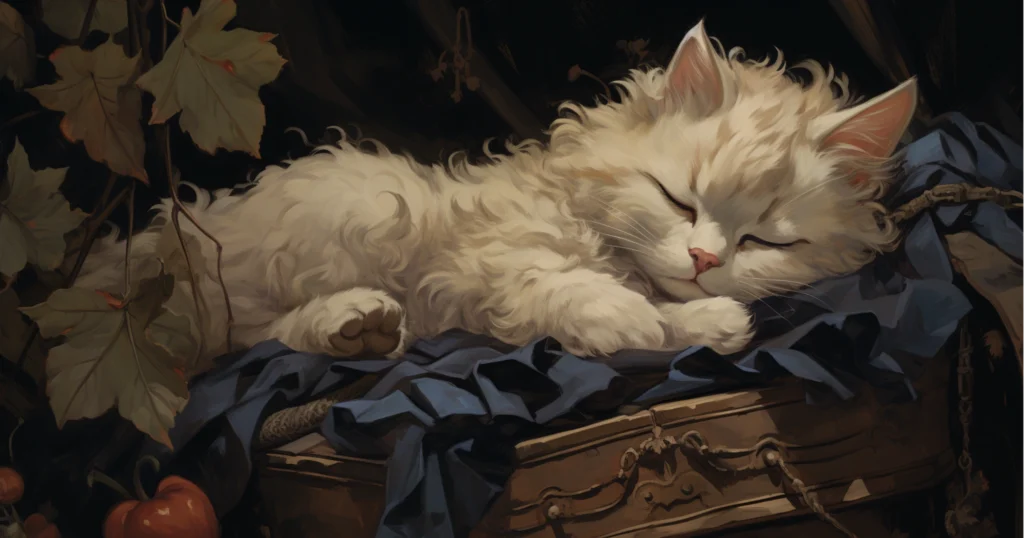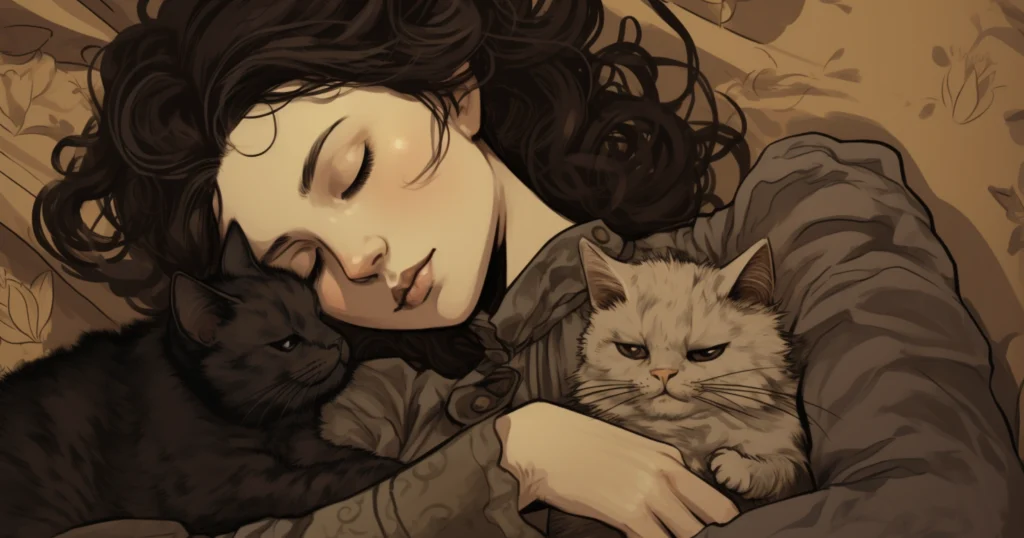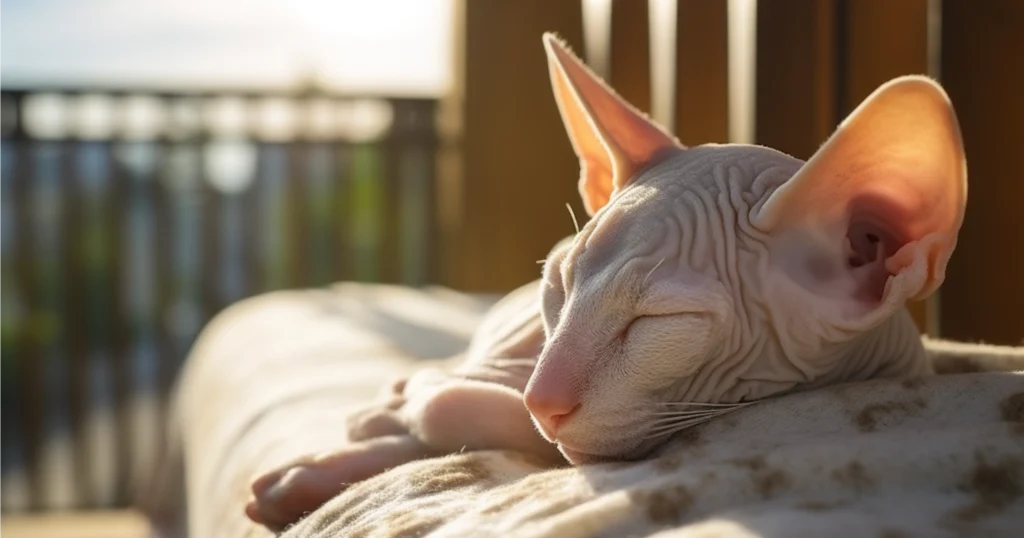Cats spend a substantial part of their day sleeping, often found in the warmest corner or the most secluded hideaway. Understanding their sleep patterns not only quenches our curiosity but also aids cat owners in ensuring optimal health for their pets.
This understanding involves recognizing different sleep types like ‘cat naps’ and REM sleep, and noticing changes as cats age. Delving into the topic of why do cats sleep so much, we’ll understand that a cat’s extended sleep time isn’t a sign of laziness – it’s instinctual and integral to their biology. Let’s explore this further.
The Biological Rhythms of Cats: Crepuscular Creatures

Ever heard the term ‘crepuscular’? It’s not exactly a common word, but it’s key to understanding why cats sleep so much. Essentially, ‘crepuscular’ refers to animals that are most active during twilight — that’s dawn and dusk to you and me. Cats fall right into this category.
Why does this matter? Well, it has a lot to do with a cat’s wild ancestors. Being active during these hours allowed them to hunt when their prey were most active, and also to avoid larger predators who were typically active during the day or night. This instinctual behavior persists in our house cats today. So, while you’re catching your Z’s at night or hustling during the day, your cat is likely off in dreamland.
But they’re not just sleeping because there’s nothing better to do. Cats use sleep to prepare for their active periods. It’s during these quiet times that their bodies repair muscles and consolidate memories – pretty similar to us humans, right? So, when twilight rolls around, your furry friend is refreshed, energized, and ready to play or hunt (even if it’s just a toy mouse!).
Understanding that cats are crepuscular creatures can bring a new perspective on their sleep schedule. It’s not excessive slumber or a sign of extreme laziness — it’s an evolutionary adaptation that has allowed them to survive and thrive. Let’s respect those cat naps, they’re more essential than we might have thought!
How Much Do Cats Sleep: The Sleeping Hours Breakdown

Have you ever wondered just how much sleep is sufficient for your furry friend? Cats, unlike us humans, are renowned for their lengthy sleeping hours, with an average cat often spending up to 70% of their lives in dreamland. However, the specific range of sleep hours can vary significantly based on a variety of factors.
Cats are incredibly flexible when it comes to their sleeping habits. Typically, a healthy adult cat may sleep between 13 to 14 hours a day, but this can stretch to a staggering 20 hours in a 24-hour period! Kittens and senior cats are likely to occupy the higher end of this scale, as kittens need plenty of sleep for growth and development, while older cats require more rest as their metabolism slows down.
But it’s not just about the age. Breed and health also play a significant role in how much a cat sleeps. For instance, breeds such as Persians and Ragdolls are known for their laid-back nature and tend to sleep more than more active breeds like the Siamese or Bengal. Additionally, a cat’s health status can impact their sleep. If your cat suddenly starts sleeping more or less than usual, it might be worth a visit to the vet, as changes in sleep patterns can sometimes indicate underlying health issues.
So, why do cats sleep so much? Cats in the wild would sleep most of the day to conserve energy for hunting. Despite the shift to domesticity, this trait has carried over, and modern-day cats still maintain this ‘sleep-to-hunt’ routine, even though their hunting is now often just play.
Remember, while cats might be champions of sleep, the quality of sleep matters too. Cats aren’t always in a deep, restorative sleep during their snooze fest. Their naps only last about 15-20 minutes per cycle, with periods of deep sleep being much shorter, typically around five minutes. Hence, ensuring your feline friend has a quiet, comfortable space for these crucial periods of deep sleep is essential for their wellbeing.
The Phenomenon of Cat Naps: Quick and Frequent

These mini-sleep sessions that cats love so much are more than just a fun quirk. They’re a testament to their wild ancestry. You see, in the wild, cats are both predators and prey. This means they need to be alert and ready to jump into action at any moment. And cat naps allow them to do just that.
The short, frequent sleep cycles are their way of conserving energy while maintaining high alertness. It’s a fantastic survival strategy. Even domesticated cats, safe and sound in our homes, carry this instinct. Isn’t that cool?
But here’s an even more exciting bit. While they might seem fast asleep, cats during these power naps are in a state of semi-alertness. Their ears twitch at the slightest sound, and their noses sniff out any unfamiliar scent. They’re ready to spring up at a moment’s notice.
REM Sleep in Cats: Dreaming Felines

Let’s step into the dreamy world of REM sleep in cats. Yeah, you read that right – cats dream just like us!
REM stands for Rapid Eye Movement, and it’s the stage of sleep where dreaming happens. For cats, this means they’re in deep slumber, and this is when the magic happens. You might notice their eyes moving rapidly under their lids, their whiskers twitching, and their paws making tiny running motions. These are signs that your cat is in REM sleep and probably dreaming about chasing mice or frolicking in a field of catnip!
But how much REM sleep do cats get? Actually, it’s less than you might think. Cats spend about 25% of their sleep in the REM stage, compared to humans, who spend about 20-25%. It’s during this REM sleep that cats consolidate and process their daily experiences – just like us!
The purpose of REM sleep in cats, like in humans, is believed to be linked with memory and learning. So, the next time you see your cat twitching or “running” in their sleep, they might be learning from their dream adventures! So, let’s let sleeping cats lie, and dream on!
The Energy Conservation Perspective: Sleep for Survival

Now that we know about the different types of sleep in cats, let’s look at sleep from an energy conservation standpoint. Here’s a question: Did you know that sleep is a survival strategy for cats? Let’s dive in and find out why!
Cats are notorious sleepers, and there’s a good reason for this. Sleep, for them, is all about saving energy. Think of it as a battery-saving mode. It helps cats conserve their strength for the essential activities they need to do, like hunting, exploring, and of course, playing with their favorite toys.
Now, let’s add another layer to this. Cats are carnivores, and their diet is high in protein. To process this protein and convert it into energy, they need plenty of rest. So, their sleep patterns are inextricably linked to their dietary habits.
In the wild, a cat’s sleep schedule would be dictated by their hunting routine. They’d sleep most of the day, conserve energy, then hunt at dawn and dusk when their prey is most active. Our domesticated felines have kept this rhythm, albeit with less hunting and more playtime.
So, it turns out, when your cat is snoozing, they’re not being lazy. They’re just efficiently managing their energy. Now, that’s a pretty smart survival strategy, don’t you think?
Age and Sleep: The Aging Cat’s Sleep Pattern

Understanding the behavior of our feline friends involves a comprehensive examination of how age influences sleep patterns in cats. Delving deeper into this topic uncovers intriguing insights into their daily routines, in particular, those of senior cats.
As cats ascend in years, a significant change unfolds in their slumber habits. Indubitably, older cats display a tendency to doze more compared to their sprightly, youthful counterparts. To comprehend this phenomenon, an explanation of why older cats tend to sleep more is necessary.
Biologically, aging cats endure a diminution of metabolic rates. This slowdown nudges their bodies towards an increased demand for rest. To recuperate, these graceful beings plunge into longer and more frequent sleep bouts, achieving a necessary equilibrium to preserve their vitality.
Moreover, an older cat’s augmented slumber period can be a manifestation of natural weariness resulting from a lifetime of agile hunting, prowling, and playful antics. In these twilight years, the cat’s instinct is to conserve energy, thus enhancing its sleep duration.
This delicate oscillation in sleep patterns is not merely an interesting behavioral aspect but a significant indicator of a cat’s health and wellbeing. A comprehensive understanding helps us empathize with and adequately care for our aging feline companions, ensuring they live out their golden years in serene contentment.
Conclusion: Cats Aren’t Lazy, They’re Adaptive!
So, it turns out our feline friends aren’t just cute, they’re incredibly adaptive! Their slumberous ways are a testament to their natural instincts, from the crepuscular rhythms they’ve inherited from their wild ancestors to their energy-saving catnaps. Not forgetting the fascinating dream-filled REM sleep and how their carnivorous diet has shaped their siesta patterns.
But here’s the kicker: their age also impacts how much they sleep, with senior cats enjoying a well-earned rest in their twilight years. So, next time you spy your kitty curled up in a ball of fluff, remember, they aren’t being lazy. They’re simply living life on their own feline terms – adaptive, smart, and oh-so-relaxed. Sleep on, dear kitties, sleep on!


